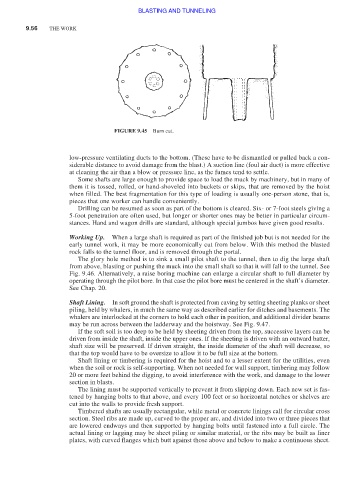Page 456 - Moving the Earth_ The Workbook of Excavation
P. 456
BLASTING AND TUNNELING
9.56 THE WORK
FIGURE 9.45 Burn cut.
low-pressure ventilating ducts to the bottom. (These have to be dismantled or pulled back a con-
siderable distance to avoid damage from the blast.) A suction line (foul air duct) is more effective
at cleaning the air than a blow or pressure line, as the fumes tend to settle.
Some shafts are large enough to provide space to load the muck by machinery, but in many of
them it is tossed, rolled, or hand-shoveled into buckets or skips, that are removed by the hoist
when filled. The best fragmentation for this type of loading is usually one-person stone, that is,
pieces that one worker can handle conveniently.
Drilling can be resumed as soon as part of the bottom is cleared. Six- or 7-foot steels giving a
5-foot penetration are often used, but longer or shorter ones may be better in particular circum-
stances. Hand and wagon drills are standard, although special jumbos have given good results.
Working Up. When a large shaft is required as part of the finished job but is not needed for the
early tunnel work, it may be more economically cut from below. With this method the blasted
rock falls to the tunnel floor, and is removed through the portal.
The glory hole method is to sink a small pilot shaft to the tunnel, then to dig the large shaft
from above, blasting or pushing the muck into the small shaft so that it will fall to the tunnel. See
Fig. 9.46. Alternatively, a raise boring machine can enlarge a circular shaft to full diameter by
operating through the pilot bore. In that case the pilot bore must be centered in the shaft’s diameter.
See Chap. 20.
Shaft Lining. In soft ground the shaft is protected from caving by setting sheeting planks or sheet
piling, held by whalers, in much the same way as described earlier for ditches and basements. The
whalers are interlocked at the corners to hold each other in position, and additional divider beams
may be run across between the ladderway and the hoistway. See Fig. 9.47.
If the soft soil is too deep to be held by sheeting driven from the top, successive layers can be
driven from inside the shaft, inside the upper ones. If the sheeting is driven with an outward batter,
shaft size will be preserved. If driven straight, the inside diameter of the shaft will decrease, so
that the top would have to be oversize to allow it to be full size at the bottom.
Shaft lining or timbering is required for the hoist and to a lesser extent for the utilities, even
when the soil or rock is self-supporting. When not needed for wall support, timbering may follow
20 or more feet behind the digging, to avoid interference with the work, and damage to the lower
section in blasts.
The lining must be supported vertically to prevent it from slipping down. Each new set is fas-
tened by hanging bolts to that above, and every 100 feet or so horizontal notches or shelves are
cut into the walls to provide fresh support.
Timbered shafts are usually rectangular, while metal or concrete linings call for circular cross
section. Steel ribs are made up, curved to the proper arc, and divided into two or three pieces that
are lowered endways and then supported by hanging bolts until fastened into a full circle. The
actual lining or lagging may be sheet piling or similar material, or the ribs may be built as liner
plates, with curved flanges which butt against those above and below to make a continuous sheet.

